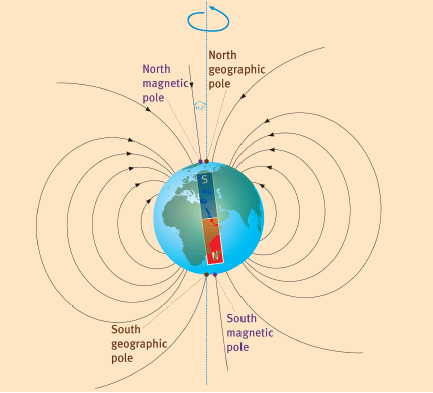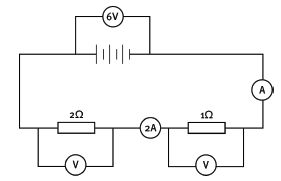Magnetism and Electricity - Physical Science Grade 10 Study Guide
Share via Whatsapp Join our WhatsApp Group Join our Telegram GroupOverview
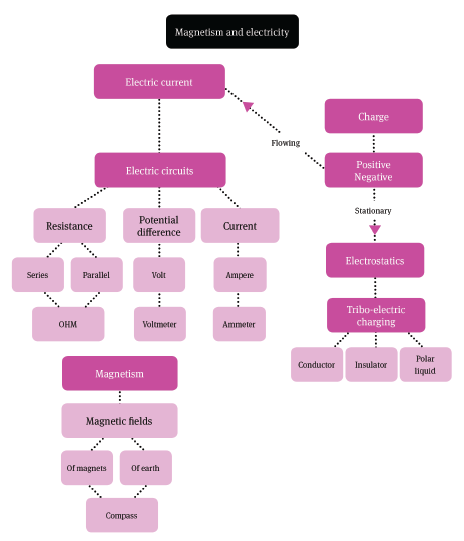
Summary
1 Magnetism
1.1 Magnetism
- A magnetic field is a region in space in which a magnet or ferromagnetic substance (iron, nickel or cobalt) will experience a force.
- The poles of a magnet are at the two ends of the magnet. The magnetic force is strongest at the poles.
- If a magnet is cut in half, each half will be a magnet with a north pole at one end and a south pole at the other.
- If a magnet is suspended at its centre so that it can turn freely, it will be affected by the magnetic field of the earth and settle in a north-south direction. The pole of a magnet that points towards the Earth’s north pole is called the north-seeking pole (or simply the north pole) of the magnet.
- Like poles of two magnets repel, unlike poles attract. So north repels north, but north attracts south.
- A compass is a magnet that is free to turn at its centre.
- A magnet is surrounded by a magnetic field – a region in which magnetic materials such as iron will experience a force.
- A compass is used to show the direction of a magnetic field.
- A magnetic field line shows the shape of the field and the direction that the north pole of a compass will point when placed in the field.
- Magnetic field lines point from north to south of a magnet.
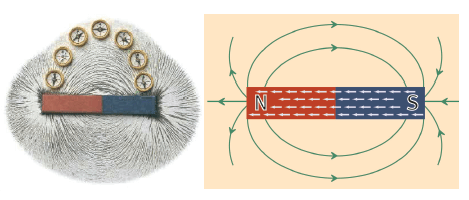
- The more closely spaced the field lines are at a point, the stronger is the field at that point, that is, the stronger the force will be on a magnetic object.
- Field lines never cross. They surround a magnet in three dimensions. For simplicity, we draw field lines in two dimensions only.
- The geographical north and south poles are the points around which the Earth rotates.
- The magnetic field of the Earth is similar to that of a bar magnet, with poles at the magnetic north and magnetic south of the Earth.
- The imaginary bar magnet inside the Earth must have its north pole at the south geomagnetic pole.
- The angle between the geographic north pole and the geomagnetic north pole is 11,5°.

- The magnetic field of the Earth protects the Earth from harmful ions of hydrogen and helium, as well as electrons emitted by the sun (solar wind). These are deflected to the poles by the magnetosphere, where they collide with the atmosphere and produce an aurora.
2 Electrostatics
2.1 Two kinds of charge
- The property of particles in atoms that enables them to attract and repel is called charge. There are only two types of charge.
- Like charges repel, unlike charges attract.
- Charges are called positive and negative because when the two types come together they cancel out to produce zero charge.
- Atoms are made up of a central nucleus comprised of positively charged protons and neutral neutrons. The nucleus is surrounded by a number of negatively charged electrons that are much smaller than protons.
- Objects become charged when electrons are either removed from them or added to them. This can be done by rubbing two materials together, called tribo-electric charging.
- An object that has an equal number of positive and negative charges is neutral.
- Conductors allow a flow of charge through them. Conductors contain charges that are free to move.
- Insulators do not allow a flow of charge through them. They do not contain charged particles that are free to move.
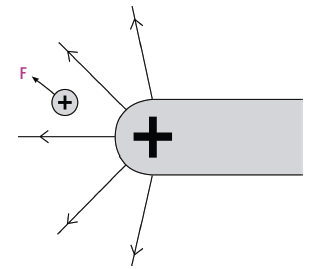
An electric field is a region in space in which an electric charge will experience a force. All charged objects are surrounded by electric fields.
- An electric field line is a line drawn with an arrow to show the direction in which a positive charge will experience a force if placed in the field.
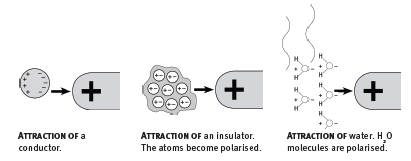
- An uncharged conductor can be attracted by a charged object. In the process, the conductor becomes polarised. Free electrons in the conductor move under the action of the electric field, making one side of the conductor negative and the other positive.
- An uncharged insulator (for instance, dust or paper) can be attracted by a charged object. Here each atom becomes polarised. Electrons in each atom move under the action of the electric field, making one side of the atom negative and the other positive.
- Water is made up of polarised molecules. The oxygen end is slightly negatively charged, and the hydrogen end slightly positively charged. A thin stream of water is attracted by a charge rod. The molecules rotate under the action of the electric field so that one side of the stream is negative and the other positive.
2.2 Conservation and quantisation
- Charge is measured in coulombs, where one coulomb is the charge carried by 6,25 × 1018 electrons.
- The principle of conservation of charge states that the net charge of an isolated system remains constant during any physical process.
- When two identical conductors that are charged are brought into contact, electrons will flow from the more negative object to the other until both have the same charge. To calculate the charge on each, simply add together the original charges and divide by two.
Q = (Q1 + Q2) / 2 - The charge on one electron (qe) is called the elementary charge.
qe = 1,6 × 10–19 C - The principle of quantisation of charge states that every charge in the universe must be a multiple of the charge on one electron.
Q = nqe where qe = 1,6 × 10–19 C.
2.2.1 Worked examples
- Two identical metal spheres A and B on insulated stands are charged. The charge on A is +6,4 μC. The charge on B is –24,6 μC. The two spheres are brought into contact, then separated.
1.1 Express each charge in C, using scientific notation.
1.2 Calculate the charge on each sphere after separation.
Answers:
1.1
- A: +6,4 × 10–9 C
B: –24,6 × 10–9 C.
For scientific notation only one figure must be before the decimal comma, so B: –2,46 × 10–8 C.
1.2
- Q = (Q1 + Q2) / 2
= [(+6,4 × 10–9) + (-2,46 × 10–8)] / 2
= 9,1 × 10–9 C
2. A glass rod is charged positively by rubbing it with a silk cloth. The charge on the rod is 1,12 × 10 –11C. Calculate the number of electrons that were rubbed off the glass rod.
Answer:
Q = nqe
n = Q / qe
= 1,12 × 10–11 / 1,6 × 10–19
= 7 × 107 electrons
3 Electric circuits
3.1 Potential difference
- An electric current is a flow of charge, positive or negative.
- A battery supplies electrons to a circuit at its negative terminal and draws them in at the positive terminal by means of a chemical reaction in the battery. So, there is a conversion of chemical potential energy in the battery to electrical potential energy of the electrons.
- The voltage measured across the terminals of a battery when it is not providing current to a circuit is called the emf of the battery.
- The voltage measured across the terminals of a battery when it is providing current to a circuit is called the potential difference across the circuit. This is always smaller than the emf, due to the fact that the battery has some resistance.
- Emf and potential difference are measured in volts with a voltmeter, which has a very high resistance and is always connected in parallel across the circuit or resistor.
3.2 Current
- Current (I) is the rate of flow of charge.
- I = Q/Δt
- While an electric current can be a flow of negative or positive charge, current direction is shown as the direction in which positive charge would move in the circuit – from positive to negative. This is referred to as ‘conventional current’.
- Current is measured in amperes (A). 1 ampere = 1 coulomb per second
- Definition of an ampere: The current in a conductor is one ampere when one coulomb of charge passes through the conductor per second.
- I = Q/Δt
- Current is measured with an ammeter, which has a very low resistance and is always connected in series.
3.2.1 Worked example
Calculate the total charge that passes through a light bulb in 2 minutes when the current is 4 amperes.
Answer:
Q = I × Δt (Δt must be expressed in seconds: 2 minutes = 120 s)
= 4 × 120
= 480 C
3.3 Resistance
- Resistance (R) is the extent to which a resistor limits the flow of charge in it. When connected to the same potential difference, the higher the resistance of the resistor, the smaller the current.
- Resistance is measured in ohms (Ω).
- Definition of an ohm: A resistor has a resistance of 1 ohm if it allows a current of 1 ampere when the potential difference across it is 1 volt. So, an ohm is a volt per ampere.
- Factors affecting resistance: Resistance depends on the type of metal, length, thickness and temperature.
- A metal will have a higher resistance if its outer electrons are held more tightly by the nucleus of the atom. So, for instance, nichrome (an alloy of nickel and chromium) has a much higher resistance than copper.
- Current in metals is a flow of loosely bound electrons in the metal. The battery sets up an electric field in the circuit. The loosely bound electrons move under the action of this field. There is a conversion of electrical potential energy into kinetic energy of the moving electrons. The electrons collide with the atoms of the metal, causing them to vibrate faster. So, there is a conversion of kinetic energy of the electrons to
vibrational kinetic energy of the atoms in the metal. The faster the atoms vibrate, the hotter they are. If very hot, they could give out light. - Energy conversions:
- Chemical potential energy in battery electrical potential energy of electrons kinetic energy of electrons vibrational kinetic energy of atoms of metal heat energy and possibly light energy.
- Resistance increases as the length of the resistor increases.
- Resistance decreases as the thickness of the resistor increases.
- Resistance increases as the temperature of the resistor is increased.
- When a resistor is added in series to an identical one, the total resistance is doubled.
- When a resistor is added in parallel to an identical one, the total resistance is halved.
- To calculate the total resistance (equivalent resistance) Rs of a number of resistors connected in series, simply add them together:
Rs = R1 + R2 + R3 …… - Current is the same at all points in a series circuit.
- Resistors in series divide the potential difference in proportion to the resistance. They are voltage dividers. Add the potential differences across each resistor together to get the potential difference across the whole circuit.
- Resistors in parallel divide the current – they are current dividers. Add the currents together to get the mainstream current.
- The voltage across each resistor in a parallel connection is the same.
- To calculate the total resistance (equivalent resistance) Rp of a number of resistors in parallel, apply the formula:
1 / Rp = 1 / R1 + 1 / R2 + 1 / R3 …..
After calculating the right-hand side of the equation, remember to invert both sides. - For two resistors in parallel, the equation can be written as:
Rp = R1R2 / (R1 + R2) (remember: product ÷ sum) - Remember that this equation can only be used for two resistors in parallel.
3.1.1 Worked examples
- In the circuit diagram below, what is:

1.1 the total resistance?
1.2 the reading on voltmeter V?
1.3 the reading on ammeter A?
Answers:
1.1
- Rs = R1 + R2
= 2 + 1
= 3 Ω
1.2 The two resistors divide the voltage of the battery. If one voltmeter reads 4 V, the other must read 2 V.
1.3 Current is the same at all points in a series circuit, so the ammeter reads 2 A.
2 In the circuit diagram below, what is: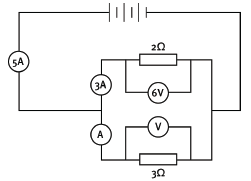
2.1 the equivalent resistance of the two resistors in parallel?
2.2 the reading on ammeter A?
2.3 the reading on voltmeter V?
Answers:
2.1
- 1 / Rp = 1 / R1 + 1 / R2 OR Rp = R1R2 / (R1 + R2)
= 1 / 2 + 1 / 3 OR = 2 × 3 / (2 + 3)
= (3 + 2) / 6 OR = 6 / 5
Rp = 6 / 5 = 1,2 Ω OR = 1,2 Ω
2.2 Resistors in parallel divide the current. The mainstream current is 5 A, and the current in one branch is 3 A. So the ammeter A must read 2 A.
2.3 The voltage must be the same as the voltage across the 2 Ω resistor. So the voltmeter V reads 6 V.
